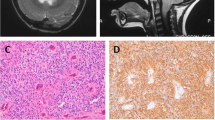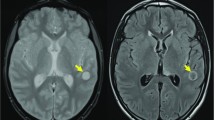Abstract
Supratentorial extra-ventricular ependymoma (SEE) are extremely rare in pediatric population and have varied presentation based on size, location, epicentre and compression on neurovascular structure. The authors report a 7-year-old girl presenting with seizure, who had a lobar SEE on MRI scan, successfully treated by microsurgical resection and adjuvant therapy.




Similar content being viewed by others
Availability of data and materials
Datasets and imaging of patients is available.
References
Byun J, Kim JH, Kim Y-H, Cho YH, Hong SH, Kim CJ (2018) Supratentorial extraventricular ependymoma: retrospective analysis of 15 patients at a single institution. World Neurosurg 118:e1–e9
Sayegh ET, Aranda D, Kim JM, Oh T, Parsa AT, Oh MC (2014) Prognosis by tumor location in adults with intracranial ependymomas. J Clin Neurosci 21(12):2096–2101
Vernet O, Farmer J-P, Meagher-Villemure K, Montes JL (1995) Supratentorial ectopic ependymoma. Can J Neurol Sci 22(4):316–319
Furie DM, Provenzale JM (1995) Supratentorial ependymomas and subependymomas: CT and MR appearance. J Comput Assist Tomogr 19(4):518–526
Schwartz TH, Kim S, Glick RS, Bagiella E, Balmaceda C, Fetell MR et al (1999) Supratentorial ependymomas in adult patients. Neurosurgery 44(4):721–731
Liu Z, Li J, Liu Z, Wang Q, Famer P, Mehta A et al (2014) Supratentorial cortical ependymoma: case series and review of the literature. Neuropathology 34(3):243–252
Lillard JC, Venable GT, Khan NR, Tatevossian RG, Dalton J, Vaughn BN et al (2019) Pediatric supratentorial ependymoma: surgical, clinical, and molecular analysis. Neurosurgery 85(1):41–49
Sun S, Wang J, Zhu M, Beejadhursing R, Gao P, Zhang X et al (2017) Clinical, radiological, and histological features and treatment outcomes of supratentorial extraventricular ependymoma: 14 cases from a single center. J Neurosurg 128(5):1396–1402
Wang M, Zhang R, Liu X, Li D, Qiu C, Zhao P et al (2018) Supratentorial extraventricular ependymomas: a retrospective study focused on long-term outcomes and prognostic factors. Clin Neurol Neurosurg 165:1–6
Jabeen S, Konar SK, Prasad C, Mahadevan A, Beniwal M, Sadashiva N et al (2020) Conventional and advanced magnetic resonance imaging features of supratentorial extraventricular ependymomas. J Comput Assist Tomogr 44(5):692–698
Metellus P, Guyotat J, Chinot O, Durand A, Barrie M, Giorgi R et al (2010) Adult intracranial WHO grade II ependymomas: long-term outcome and prognostic factor analysis in a series of 114 patients. Neuro Oncol 12(9):976–984
Hollon T, Nguyen V, Smith BW, Lewis S, Junck L, Orringer DA (2016) Supratentorial hemispheric ependymomas: an analysis of 109 adults for survival and prognostic factors. J Neurosurg 125(2):410–418
Schild SE, Nisi K, Scheithauer BW, Wong WW, Lyons MK, Schomberg PJ et al (1998) The results of radiotherapy for ependymomas: the Mayo Clinic experience. Int J Rad Oncol Biol Phys 42(5):953–8
McLaughlin MP, Marcus Jr RB, Buatti JM, McCollough WM, Mickle JP, Kedar A et al (1998) Ependymoma: results, prognostic factors and treatment recommendations. Int J Rad Oncol Biol Phys 40(4):845–50
Stüben G, Stuschke M, Kroll M, Havers W, Sack H (1997) Postoperative radiotherapy of spinal and intracranial ependymomas: analysis of prognostic factors. Radiother Oncol 45(1):3–10
Guyotat J, Signorelli F, Desme S, Frappaz D, Madarassy G, FevreMontange M et al (2002) Intracranial ependymomas in adult patients: analyses of prognostic factors. J Neurooncol 60:255–268
Reni M, Brandes AA, Vavassori V, Cavallo G, Casagrande F, Vastola F et al (2004) A multicenter study of the prognosis and treatment of adult brain ependymal tumors. Cancer: Interdiscip Int J Am Cancer Soc 100(6):1221–9
Palma L, Celli P, Cantore G (1993) Supratentorial ependymomas of the first two decades of life. Long-term follow-up of 20 cases (including two subependymomas). Neurosurgery 32(2):169–75
Ono S, Ichikawa T, Ono Y, Date I (2004) Large supratentorial ectopic ependymoma with massive calcification and cyst formation—case report—. Neurol Med Chir 44(8):424–428
Alexiou GA, Panagopoulos D, Moschovi M, Stefanaki K, Sfakianos G, Prodromou N (2011) Supratentorial extraventricular anaplastic ependymoma in a 10-year-old girl. Pediatr Neurosurg 46(6):480–481
Khilji MF, Hamid RS, Qureshi A (2014) Supratentorial extraventricular anaplastic ependymoma in a child. Case Rep 2014:bcr2014203750.
Satyarthee GD, Moscote-Salazar LR (2016) Extra-axial giant falcine ependymoma with ultra-rapid growth in child: uncommon entity with literature review. J Pediatr Neurosci 11(4):324
Takaki Y, Tsutsumi S, Teramoto S, Nonaka S, Okura H, Suzuki T et al (2021) Supratentorial extraventricular ependymoma presenting calvarial erosion: a report of 3 cases. Radiol Case Rep 16(10):3003–3006
Author information
Authors and Affiliations
Contributions
Sivaraman Kumarasamy—Conception & design of work, acquistion, analysis, interpretation of data and drafted the work. Guru Dutta Satyarthee – Analysis, interpretation of data and revised the drafted work. All authors have approved the submitted version (and any substantially modified version that involves the author's contribution to the study) and agreed both to be personally accountable for the contributions and to ensure that questions related to the accuracy or integrity of any part of the work.
Corresponding author
Ethics declarations
Ethical approval
Consent to participate and consent for publication was taken from the patient using written informed consent to publish from the parent. Ethics committee approval was obtained.
Conflict of interest
No financial and non-financial competing interests.
Additional information
Publisher's Note
Springer Nature remains neutral with regard to jurisdictional claims in published maps and institutional affiliations.
Rights and permissions
Springer Nature or its licensor (e.g. a society or other partner) holds exclusive rights to this article under a publishing agreement with the author(s) or other rightsholder(s); author self-archiving of the accepted manuscript version of this article is solely governed by the terms of such publishing agreement and applicable law.
About this article
Cite this article
Kumarasamy, S., Satyarthee, G.D. Supratentorial extra-ventricular ependymoma as a mass lesion in a child: report and literature review. Childs Nerv Syst 40, 1583–1589 (2024). https://doi.org/10.1007/s00381-023-06250-2
Received:
Accepted:
Published:
Issue Date:
DOI: https://doi.org/10.1007/s00381-023-06250-2




